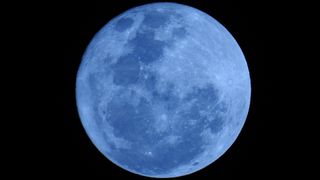Why Did We Have Blue Moon Why Do We Have Blue Moons
Blue Moon: What is it and when does it occur?

"Once in a Blue moon" is a phrase commonly used to describe an incredibly rare event, but what does it mean in astronomical terms? Can the moon turn blue?
There are two types of Blue Moons but unfortunately neither has anything to do with color.
A seasonal Blue Moon is the traditional definition of a Blue Moon and refers to the third full moon in a season that has four full moons according to NASA (opens in new tab). Whilst the second definition — borne out of a misunderstanding of the first — is a monthly Blue Moon which refers to the second full moon within a single calendar month. The monthly Blue Moon is nowadays considered the second definition of a Blue Moon rather than a mistake, according to Time and Date (opens in new tab).
Related: What is a blood moon?
What is a Blue Moon?
As the cycle of the phases of the moon lasts approximately one month, we typically experience 12 full moons each year. Many cultures have given distinct names to each month's full moon. 12 months, 12 full moons, 12 names. Simple right?
Well, not quite. Here's where the Blue Moon comes into the equation.
The moon phases actually take 29.5 days to complete which means it takes just 354 days to complete 12 lunar cycles. So every 2.5 years or so a 13th full moon is observed within a calendar year.
This 13th full moon doesn't conform to the normal naming scheme and is referred to as the Blue Moon.
How often do Blue Moons occur?
Contrary to the popular phrase "once in a blue moon", Blue Moons can occur relatively frequently, that is, in astronomical terms.
Blue Moons occur once every two to three years, according to NASA. As there are roughly 29.5 days between full moons, February will never experience a monthly Blue Moon as it only has 28 days in a common year and 29 in a leap year. Sometimes February doesn't have a Full Moon at all, this is known as a Black Moon, according to Time and Date.
When is the next Blue Moon?
The next monthly Blue Moon is on Aug. 30/31, 2023 according to Time and Date. The next seasonal Blue Moon will take place on Aug. 19/20, 2024.
When was the last Blue Moon?
The last Blue Moon was on Aug. 22, 2021, and thrilled skywatchers worldwide.
Related: Rare Blue Moon, the last until 2023, wows stargazers (photos)
If you're interested in trying to capture an impressive lunar image yourself and want to learn the right techniques and tools, check out our handy how to photograph the moon guide.
Can the moon ever turn blue?
Yes! But this is a very rare event, in fact, you could say it happens "once in a Blue Moon".
According to NASA in 1883 an Indonesian volcano called Krakatoa erupted and spread ash as high as 50 miles (80 kilometers) into the atmosphere. The tiny ash particles — about one micron in size — acted as a filter, scattering red light and turning the moon a distinct blue-green hue.
According to NASA Science (opens in new tab), other volcanic eruptions have also been known to cause blue moons including the 1983 eruption of El Chichon volcano in Mexico and the eruptions of Mt. St. Helens in 1980 and Mount Pinatubo in 1991.
Additional information
Explore Blue Moons in a nutshell with ESA's useful Blue Moon infographic (opens in new tab). Check out this cool image (opens in new tab) of a Blue Moon captured by the European weather satellite MSG-3 just before the moon disappeared out of sight. Discover the difference between (opens in new tab) types of full moons with NASA.
Bibliography
Mohon, L. (2021, August 20). Blue Moon – Watch the skies. NASA. Retrieved April 21, 2022, from https://blogs.nasa.gov/Watch_the_Skies/tag/blue-moon/
NASA. (n.d.). Blue Moon. NASA. Retrieved April 21, 2022, from https://science.nasa.gov/science-news/science-at-nasa/2004/07jul_bluemoon
Hocken, V., & Kher, A. Look up for a blue moon! What Is a Blue Moon? Retrieved April 21, 2022, from https://www.timeanddate.com/astronomy/moon/blue-moon.html#:~:text=The%20next%20monthly%20Blue%20Moon,are%20traditionally%20called%20Sturgeon%20Moons.&text=There%20is%20no%20Blue%20Moon%20in%202022.
Join our Space Forums to keep talking space on the latest missions, night sky and more! And if you have a news tip, correction or comment, let us know at: community@space.com.
Source: https://www.space.com/15455-blue-moon.html
0 Response to "Why Did We Have Blue Moon Why Do We Have Blue Moons"
Post a Comment